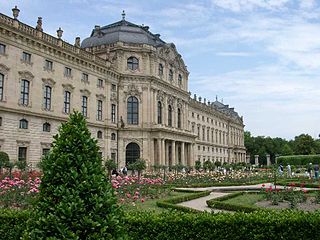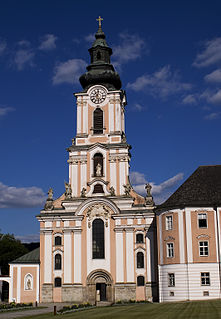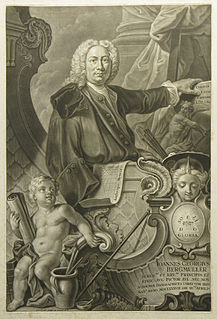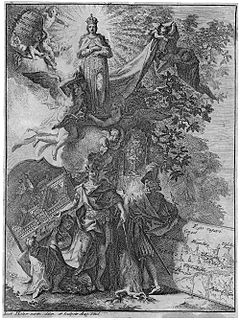This article needs additional citations for verification .(March 2021) |


Franz Anton Zeiller (3 May 1716, Reutte - 4 March 1794, Reutte) was an Austrian painter, in the Rococo style.
This article needs additional citations for verification .(March 2021) |


Franz Anton Zeiller (3 May 1716, Reutte - 4 March 1794, Reutte) was an Austrian painter, in the Rococo style.
He lost his parents at a very early age. The painter, Paul Zeiller, who already had ten children of his own, adopted him into his family. He recognized Franz's talent almost immediately, and began giving him lessons. After 1728, Balthasar Riepp, who had married one of Zeiller's daughters, also began working in his studio and provided Franz with lessons in fresco painting. Franz remained there until Zeiller's death in 1738, then left Reutte.
His travels initially took him to Augsburg, where he came under the stylistic influence of Johann Evangelist Holzer; working as his assistant on a church painting project. Following Holzer's death in 1740, aged only thirty-one, he began working for Gottfried Bernhard Göz, who was also an engraver. He stayed with Göz for two years, then took some money he had saved and set off for Italy.
He was in Rome from 1742 to 1744 then, following a brief visit to Bologna, lived in Venice from 1744 to 1749. While in Rome, he worked with Corrado Giaquinto and copied some of the Old Masters. His personal notes of his time there have been preserved. [1] He also copied works in Venice, and was especially impressed by Titian. After returning home, he again worked for Göz; assisting him with a ceiling fresco at the Wallfahrtskirche Birnau . Later, he became involved in creating a large cycle of paintings at Kaisheim Abbey. [2]
His first personal commission came in 1752, from St. Mang's Abbey, Füssen, where the abbot, Gallus Zeiller, was a distant relative. After painting the chapel there, he was awarded a commission to execute frescoes and an altar painting at the parish church of St. Martin, in Schwabsoien, which was associated with the Abbey. He then worked with Johann Jakob Zeiller, Paul's son, at Ottobeuren Abbey. This was followed by a long series of projects, throughout Upper Bavaria and the Tyrol.
In 1768, the completion of some major works in Brixen led to his appointment as court painter there. He held that position until 1783, when Johann Jakob died, and he returned to Reutte to complete some of his commissions that had been left unfinished. When that was accomplished, he remained there with his adoptive family and continued to be active, creating small works, and one large fresco for the choir at a church in Grän. He died there in 1794, from an attack of "dropsy". He had never married and lived a modest life, thereby accumulating a considerable fortune.

Giovanni Battista Tiepolo, also known as GiambattistaTiepolo, was an Italian painter and printmaker from the Republic of Venice who painted in the Rococo style, considered an important member of the 18th-century Venetian school. He was prolific, and worked not only in Italy, but also in Germany and Spain.

Johann Balthasar Neumann, usually known as Balthasar Neumann, was a German architect and military artillery engineer who developed a refined brand of Baroque architecture, fusing Austrian, Bohemian, Italian, and French elements to design some of the most impressive buildings of the period, including the Würzburg Residence and the Basilica of the Fourteen Holy Helpers.

The Würzburg Residence is a palace in Würzburg, Germany. Johann Lukas von Hildebrandt and Maximilian von Welsch, representatives of the Austrian/South German Baroque style, were involved in the construction, as well as Robert de Cotte and Germain Boffrand, who were followers of the French Style. Balthasar Neumann, court architect of the Bishop of Würzburg, was the principal architect of the Residence, which was commissioned by the Prince-Bishop of Würzburg Johann Philipp Franz von Schönborn and his brother Friedrich Carl von Schönborn in 1720, and completed in 1744. The Venetian painter Giovanni Battista Tiepolo, assisted by his son, Domenico, painted frescoes in the building.

Reutte is a market town in the Austrian state of Tyrol. It is the administrative center of the Reutte district. Reutte is located on the Lech, and has a population of 6704.

Wilhering Abbey is a Cistercian monastery in Wilhering in Upper Austria, about 8 km (5 mi) from Linz. The buildings, re-constructed in the 18th century, are known for their spectacular Rococo decoration.

Johann Rasso Januarius Zick was a German painter and architect. He is considered to be one of the main masters of the Late-Baroque.

St. Mang's Abbey, Füssen or Füssen Abbey was a Benedictine monastery in Füssen in Bavaria, Germany. It was founded in the 9th century, and dissolved during the post-Napoleonic secularisation of Bavaria.

Johann Joseph Christian was a German Baroque sculptor and woodcarver. His masterworks are considered to be the choir stalls in Zwiefalten Abbey and Ottobeuren Abbey.

Matthäus Günther was an important German painter and artist of the Baroque and Rococo era.

Breitenwang is a municipality and village in the district of Reutte in the Austrian state of Tyrol.

Johann Georg Bergmüller was a German painter, particularly of frescoes, of the Baroque.

St. Florian Monastery is an Augustinian monastery in the town of Sankt Florian, Austria. Founded in the early ninth century, and later refounded by Augustinians in the eleventh century, St. Florian is the largest monastery in Upper Austria, and rivals Melk Abbey and Klosterneuburg Monastery as among the most impressive examples of Baroque architecture in Austria. The monastery is dedicated to Saint Florian, whose fourth century grave lies beneath the monastery.

Johann Evangelist Holzer was an Austrian-German painter.

Paul Troger was an Austrian painter, draughtsman, and printmaker of the late Baroque period. Troger's illusionistic ceiling paintings in fresco are notable for their dramatic vitality of movement and their palette of light colors.

Johann Jakob Zeiller was an Austrian painter.

Paul Zeiller was an Austrian painter in the Baroque style. From 1692, he had a workshop in Reutte that later became an art school. His son, Johann Jakob Zeiller and adopted son, Franz Anton Zeiller, both received their first lessons there.

Balthasar Riepp was a German-Austrian painter, primarily of religious subjects.

Gottfried Bernhard Göz, also Goez, Goetz or Götz was a German Rococo painter and engraver.

Georg Anton Urlaub was a Baroque painter from Franconia. He was associated for part of his career with the court of the prince bishop of Würzburg and painted portraits and also many frescoes and altarpieces for churches in Lower Franconia.

Jacob Carl Stauder was a Swiss-German painter in the Baroque style.
![]() Media related to Franz Anton Zeiller at Wikimedia Commons
Media related to Franz Anton Zeiller at Wikimedia Commons